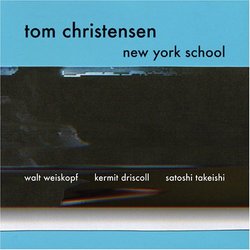Talent on the rise
Troy Collins | Lancaster, PA United States | 06/13/2005
(4 out of 5 stars)
"Multi-instrumentalist and composer Tom Christensen draws inspiration from the same opulent well as his peers Ben Allison, Jason Moran, Ron Horton and Russ Johnson, to name but a few. This new breed of jazz musician, as enamored of fervent free-jazz improvisation as they are advance harmony and pop-song melodies, is an eclectic bunch. Capable of creating readily accessible but highly adventurous music, they have found that the middle ground between free improvisation and rigid formalism has its own rewards.
With the (now traditional) post-Ornette, piano-less quartet line-up of upright bassist and percussionist backing a two horn front line, Christensen's quartet has a surprisingly vast color palette to draw from. With the leader doubling on eight different reed instruments alone, from tenor saxophone to wood flute, combined with percussionist Satoshi Takeishi's arsenal of available devices, the quartet has a veritable world of sound at their disposal.
"New York School" is inspired by the work of various artists from the post-war era, including beat poets and abstract expressionist painters. This era marked the beginning of the West's burgeoning fascination with Eastern culture and it is in this conceit that Christensen's quartet finds their conceptual inspiration. With hand drumming, exotic metallic percussion and wood flutes, sinewy soprano saxophone lines and moody bass clarinet, the quartet espouses its Eastern inspired world view. By locking into stripped down funky blues grooves bustling underneath dueling tenor saxophones that are by turns meditative and rapturous, the four represent their Western lineage with post-bop aplomb.
"Oranges" demonstrates the ensemble's perfect commingling of its Eastern and Western conception. This multi-part composition goes through no less than a half dozen changes in mood and tempo. Quiet Asiatic flute passages, bowed bass, skittering metallic percussion and sporadic hand drumming modulate into a sultry blues vamp with smoky tenor saxophone which transforms again into an accapella tenor saxophone duel. A short but funky bass and drum interlude leads into an almost chamber music-esque meditation on paired clarinets and a delicate bass figure. A plaintive bass solo takes the group into a swinging bop line that ends the composition on a high note.
Christensen's writing style has the same rich melodic flow that one hears in the compositions of such obvious inspirations as Thomas Chapin ("Guardians") and especially Marty Ehrlich ("Asleep and Sleeping With Them"). Although the quartet's improvisations are more subdued than either of those artists more outre tendencies, their playing is by no means derivative or uninspired. Never sonically overburdened, Christensen's writing style is just as dependent on space as it is on melody and rhythm. With episodic multi-part compositions and a tendency to vacillate back and forth between the aforementioned Eastern and Western inspired excursion, Christensen is definitely a talent on the rise."


 Track Listings (7) - Disc #1
Track Listings (7) - Disc #1